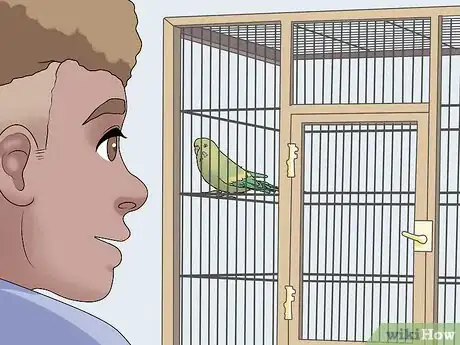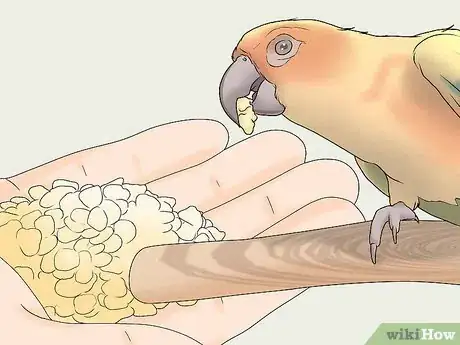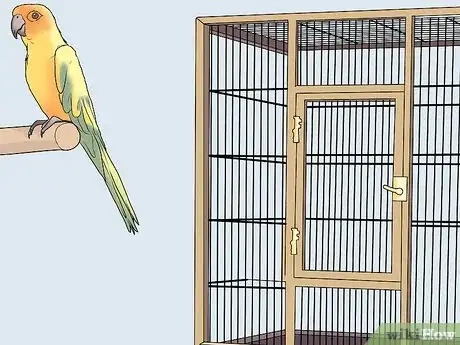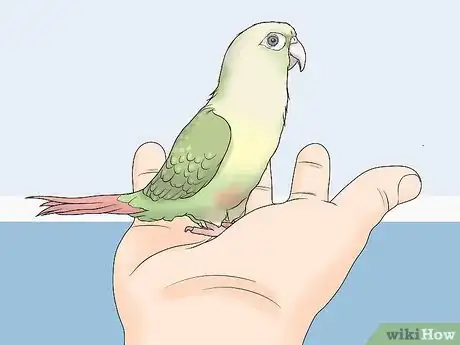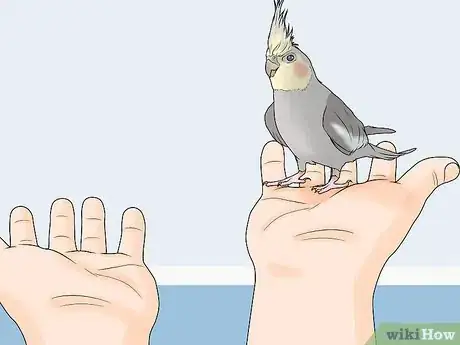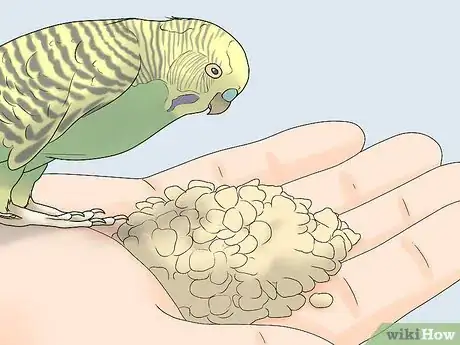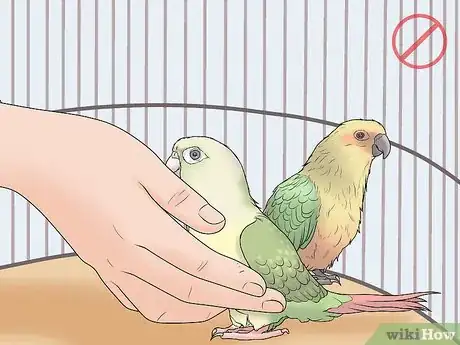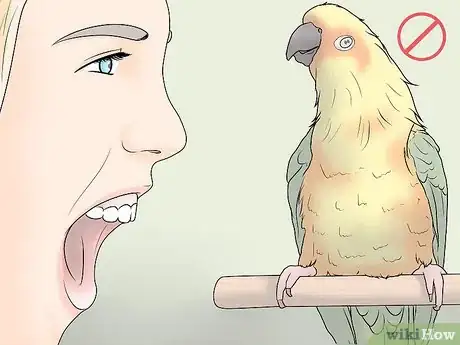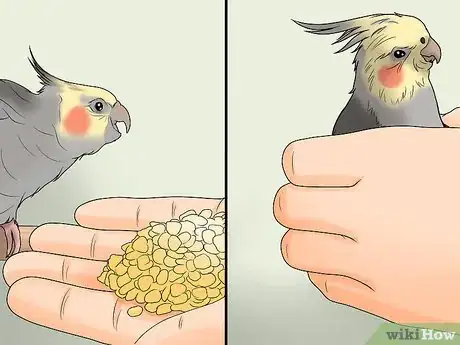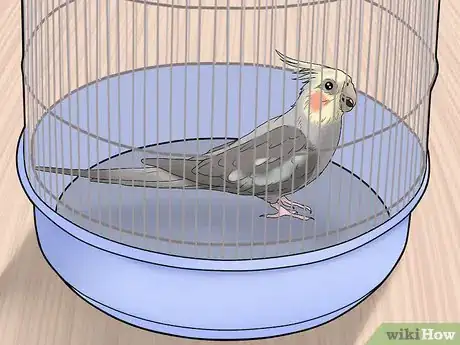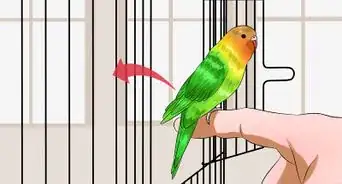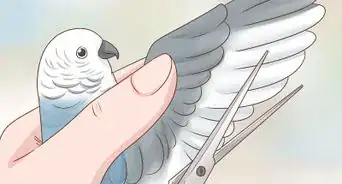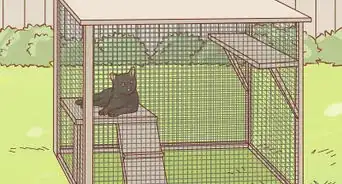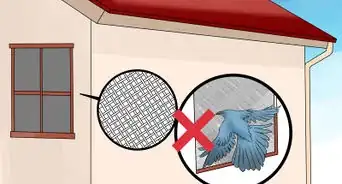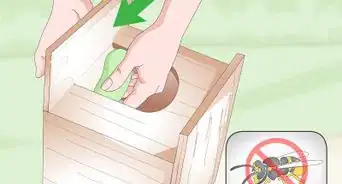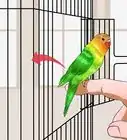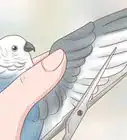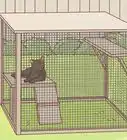This article was co-authored by Pippa Elliott, MRCVS. Dr. Elliott, BVMS, MRCVS is a veterinarian with over 30 years of experience in veterinary surgery and companion animal practice. She graduated from the University of Glasgow in 1987 with a degree in veterinary medicine and surgery. She has worked at the same animal clinic in her hometown for over 20 years.
wikiHow marks an article as reader-approved once it receives enough positive feedback. In this case, 85% of readers who voted found the article helpful, earning it our reader-approved status.
This article has been viewed 120,549 times.
Birds can make great companions and pets. However, if your bird is nervous around you or new to your home you will need to work to gain their trust. Forcing any interaction will only hurt your relationship. In order to make sure your feathered friend is happy and healthy patiently work with it to build trust between you.
Steps
Gaining Your Bird's Trust
-
1Spend time around your bird. Birds are social creatures that need to spend time with you or other birds. However, if your bird is new to you it may not trust you enough to be comfortable around you. By spending as much time as you can with your bird you will help it to relax and feel that it can trust you.[1]
- Try reading a book or some other calm or quiet activity near your birds cage.
- Gently and quietly speak to your bird to allow it to get used to your voice.
- Birds need social interaction to be happy.
-
2Learn your bird's body language. Even though some birds can mimic human speech it will communicate through their body language. Learning how your bird communicates with its movements will help you realize when your bird is feeling comfortable and when it's nervous. If your bird is showing signs of being nervous, take a break and try bonding some other time.
- Birds will hiss and spread their tail feathers if annoyed.[2]
- It may also back into a corner, sway their body, puff out their feathers or put their crest feather down.
- Birds may lower their head, tucking it in. This is usually a sign it are comfortable and want you to give it a head scratch.
Advertisement -
3Give your bird treats. Food can be a great reward for good behavior and a way to build trust. If you bird is being brave or showing good behavior, try giving it a treat to make it feel even more comfortable around you.
- Try to find out which foods your bird likes the most. Offer many treats and see what it enjoy.
- Birds should eat fruit, vegetables and seeds.
-
4Let your bird out of the cage. Once your bird has had some time to become comfortable in your home or in a new environment you can try to let it out of their cage. Letting it out of the cage can help it feel more comfortable in your home and around you, building the amount of trust it feels.
- Hold some food in your hand near the open cage door.
- Don't make eye contact as this can make your bird feel nervous.
- Don't force your bird out of the cage. Let the bird come out on its own.
- You may want to have your bird's feathers clipped to prevent it from flying into a window or wall.
- Spending too much time in the cage can make your bird nervous about leaving it.
Building Trust With The Step-Up Command
-
1Let the bird sit on your hand. The first step when teaching your bird the step-up command is letting it out of the cage and having it sit on a hand. After it sits on your hand you will be able to use your other hand to start teaching it how to step up.[3]
- Once your bird steps out of the cage, offer your hand to it as a platform.
- Move slowly and make sure your bird stays comfortable.
-
2Bring your other hand up to the bird. The aim of the step up command is to have your bird step from one hand to the other. To do this you will need to bring your other hand up to the bird, offering a new platform for it to move up to. Keep some of the following tips in mind as you work with your bird:[4]
- If your bird bites, move your hand in from underneath the bird.
- Bring your hand up to the area just above where your bird's legs meet its body.
- Keep your hand flat and level.
-
3Reward the bird for stepping up. Whenever your bird steps up successfully you can offer it a reward. Giving your bird a tasty treat will help it understand that stepping up onto your other hand will result in rewards. Always offer a reward when training your bird to step-up in order to get the best results.[5]
- Try to give your bird their favorite treat as a reward.
- Many birds love fresh vegetables, fruits, or seeds.
-
4Practice often. Without enough training your bird may forget the step-up command or never properly learn it in the first place. Whenever your bird is feeling comfortable you should try working with it, spending time with it, and reinforcing the step-up command to build even more trust.[6]
Keeping Trust Strong
-
1Avoid forcing your bird into doing something. Pet birds have their own will and you will need to have patience and work with it. Never force your bird into doing anything that it seems uncomfortable or upset doing. Forcing your bird will only cause distrust and fear to develop between you.
- Forcing your bird into doing something can result in you being bitten.
-
2Don't hit or yell at your bird. No matter how frustrated you may feel with your bird you can never hit or yell at it. Birds will absolutely not respond to hitting or yelling and doing so will only destroy any sense of trust in your relationship. Always be kind and patient when working with your bird in order to maintain trust.
-
3Avoid tricking your bird. In order to maintain trust between you and your pet bird you will need to always be “honest” with it. Tricking it into thinking it is about to do one thing and then having it do another can destroy trust. Always keep your commands consistent and clear when engaging with your bird.
-
4Take a break if your bird is upset. Spending time with your pet bird can be a lot of fun for both of you. However, your bird might get tired or cranky for any number of reasons. If your bird starts to display signs of discomfort or annoyance it should return their cage immediately. Give it some time to rest in their cage before resuming any direct interaction again.
Warnings
- Never force your bird to do something it don't want to.⧼thumbs_response⧽
- Never hit or yell at your bird.⧼thumbs_response⧽
References
About This Article
To gain your bird’s trust, spend as much time as you can around it so that it gets comfortable with your presence. During these times, talk to your bird in a quiet, gentle voice so it feels relaxed around you. Additionally, give it a treat, like a piece of fruit or vegetable, as a reward when it comes closer to you or shows good behavior. Once your bird seems comfortable interacting with you through the cage, try taking it out of the cage by encouraging it to step up onto your hand. For more advice from our Veterinary co-author, including how to read your bird’s body language, keep reading!
